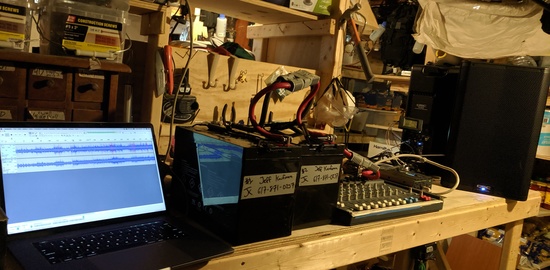Battery Powered Contra II |
August 17th, 2019 |
| battery, contra, power, sound |
The way the system failed was that when I would play especially loud bass notes on the piano the inverter would briefly switch off. This makes sense: amplifying bass requires a lot of power. If we hadn't had the generator we could have used EQ to take most of the bass out of things and probably done ok, but what would I need to run a full dance with good sound on just battery?
I had three guesses about what might be wrong:
-
The inverter was not able to handle its full rated power.
I was using the cables that came with the inverter. They weren't marked for AWG, but they did say 4mm2. That corresponds to 12 AWG, which is way too low for an inverter with a surge rating of 1000W.
While I had two batteries, I didn't have them wired together. This meant I was only running the system off of one battery at a time. The more current you draw from a battery the more its internal resistance starts to matter.
In my earlier testing I was seeing a draw of ~200W, and because sound can have some very sharp peaks I want to be using wires that can handle the full 1000W surge current the inverter is rated for. At 12V, 1000W is 83A, which is a lot. There was probably 3ft of wiring, round trip, so my 4mm2 wires were probably seeing a peak voltage drop of maybe ~7%. Using 4 AWG wire would bring us to ~1% loss, but to be on the safe side I decided to go with 2 AWG since the cost increase for such short wires was small.
I also wanted to wire the batteries in parallel, so they could both be supplying power at once. With this many things to connect, I also wanted to be using proper connectors instead of clip-on jaws. It looks like Anderson SB connectors are very standard for this sort of thing, so I decided to wire this up as:
+-------------+
+--| 12v battery |--+
| +-------------+ |
+--------+ +--------+
SBC
SBC
+--------+ +--------+
| +-------------+ |
+--| 12v battery |--+
| +-------------+ |
+--------+ +--------+
SBC
SBC
+--------+ +--------+
| +--------------+ |
+--| 12v inverter |-+
+--------------+
[ac]
This is four SB 175 connectors, each with their 5/16" lugs bolted to
something: one on the first battery, two on the second battery, and
one on the inverter. It's possible to buy the parts yourself and
assemble them, but after looking into the tools I would need to solder
or crimp them, and the chance that I would screw it up and need to
re-order, I decided to just buy them already assembled.
Here it is, all set up for testing with two QSC K10.2s:
I tested with a relatively loud section of a recent Kingfisher Amherst gig (mp3). If I turned it up loud enough it would start cutting out, but I had to make it very loud. I turned it down until it reliably wouldn't cut out, which was still very loud. I don't have a way to quantify how loud it was, but:
- Wearing my 28dB hearing protection it was unpleasantly loud.
- This was 15dB louder (according to the mixer) than the maximum volume I could tolerate with no hearing protection at 10ft.
Running at this volume, the power meter I had on the battery varied with the music's transients and it's hard to know the peak power usage because I don't know how short a period it's averaging over. I'm guessing the peak was just below 1000W, though, because that's what we'd expect from the inverter's surge rating. The most the meter read was ~300W. When I took measurements before I only got up to 75W, and when I was trying it at the dance I saw the power cutting out when the meter hit ~200W, so it does sound like it's doing better.
The meter also has Wh measurement, and I measured it as using 10 Wh in 266s and then again 13 Wh in 309s. That comes to 135W and 151W on average for very high energy parts of music.
I also had a kill-a-watt style meter hooked up on the AC side of the inverter. It measured a maximum of just under 2A (240W) with a power factor between 0.60 and 0.75.
Overall this does now look like the problems from before are resolved and this should work, but it's hard to say for sure without trying it outside in an environment more like a dance.
(We should also be fine for a capacity perspective. At high draw we were talking about 2Wh per minute, so a 3hr dance would be 360Wh. I have two 100Ah batteries at 12V, so this is a 15% discharge. Double this for everything else on stage that uses power, and we're still only at 30%.)
Comment via: facebook, substack
